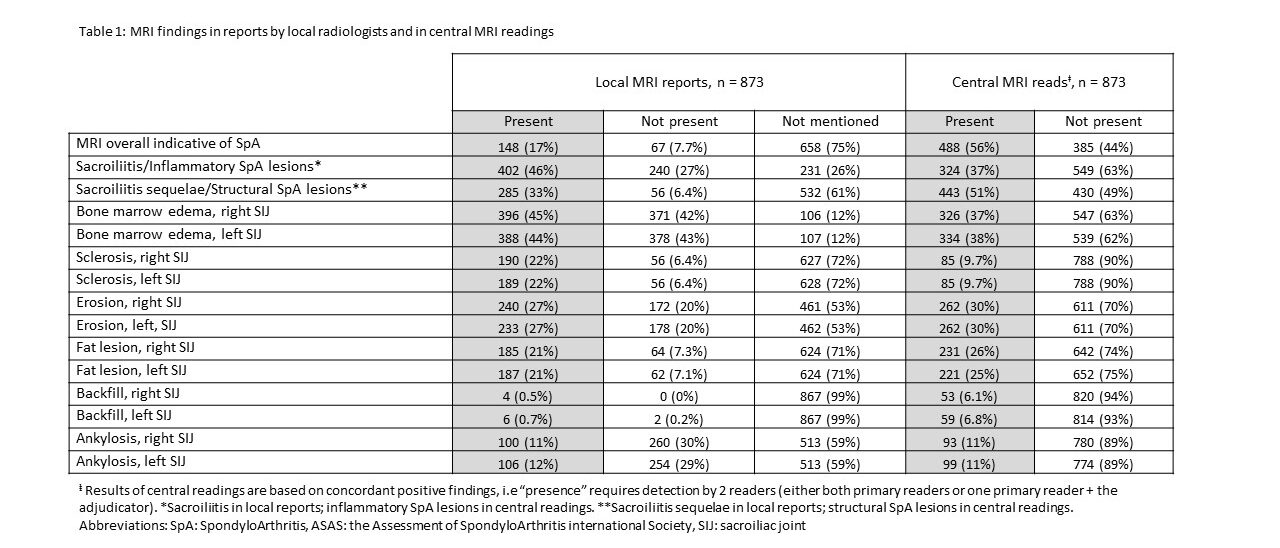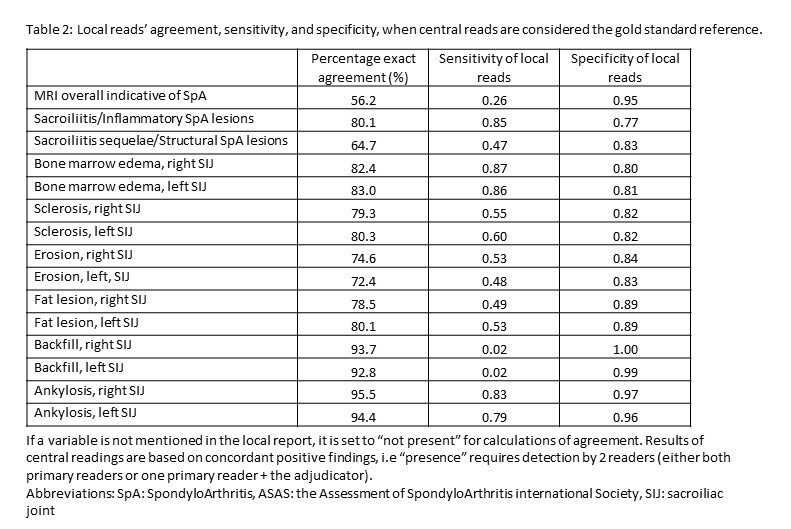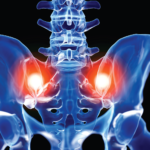Abstract 0224 presented at ACR Convergence 2024
Background/Purpose
Magnetic resonance imaging (MRI) of the sacroiliac joints is widely used for diagnosing and monitoring patients with spondyloarthritis (SpA). However, local radiologists may be less familiar [than rheumatologists] with assessing MRIs in patients with spondyloarthritis potentially leading to misinterpretations and affecting the final diagnosis. We compared assessments of sacroiliac joint MRIs in patients with a diagnosis of axial spondyloarthritis (axSpA) or psoriatic arthritis (PsA) in local MRI reports from routine care in five European countries with re-reads by central experts to estimate the extent of over- or under-reporting of features and misclassification.
Methods
We included patients with a diagnosis of axSpA or PsA in a clinical patient registry from one of five European countries (DANBIO, Denmark; SCQM, Switzerland; ATTRA, Czech Republic; biorx.si, Slovenia; ICEBIO, Iceland; all participating in the EuroSpA Research Collaboration Network) with an available MRI of the sacroiliac joints and a corresponding local MRI report. MRIs were collected and read centrally by two experienced readers, blinded to clinical (except sex and age) and other imaging information. Readers registered whether the MRI was overall indicative of axSpA. In case of disagreement, MRIs were adjudicated by an experienced musculoskeletal radiologist (member of the ASAS/EULAR MRI group). Further, presence/absence of inflammatory and structural lesions (details in Table 1) were registered. Similar information was extracted from the local reports. Findings in local reports and central assessments were compared using central reads as reference standard.
Results
Overall, 873 patients with an MRI of the sacroiliac joints and a corresponding local MRI report were included; mean age 37.9 years, 475 (54%) male and 704/169 diagnosed with axSpA/PsA (see Table 1). Sacroiliitis/inflammatory SpA lesions were reported more often in local vs central reads (46% vs. 37%). Sacroiliitis sequelae/structural SpA lesions were reported less often in local vs. central reads (33% vs. 51%). In 17% of cases, local reads explicitly reported if the MRI was overall indicative of axSpA or not. On lesion level, bone marrow edema was the most frequent lesion judged present, both in local and central reads (right/left joint 45%/44% vs. 38%/37%, respectively), followed by erosion (27%/27% vs. 30%/30%). Compared with central reads, local reads tended to overestimate presence of bone marrow edema and sclerosis, underestimate/not assess backfill, while the frequency of erosions, fat and ankylosis was similar. Figure 1 shows examples with disagreement. The sensitivity and specificity of local reads were 0.85 and 0.78 for sacroiliitis/inflammatory SpA lesions, and 0.48 and 0.83 for sacroiliitis sequelae/structural SpA lesions, respectively (see Table 2). For individual lesions, the sensitivity of local reads was highest for BME and ankylosis, followed by sclerosis. The specificity of local reads was ≥0.80 for all lesions.
The sensitivity and specificity of local reads were 0.85 and 0.78 for sacroiliitis/inflammatory SpA lesions, and 0.48 and 0.83 for sacroiliitis sequelae/structural SpA lesions, respectively (see Table 2). For individual lesions, the sensitivity of local reads was highest for BME and ankylosis, followed by sclerosis. The specificity of local reads was ≥0.80 for all lesions.
Conclusion
This large European real-world study overall showed moderate agreement between local and central reads, but also demonstrated that local radiologists tend to overestimate inflammatory lesions and underestimate structural lesions in routine care sacroiliac joint MRIs. This speaks to a need for further training of local radiologists to optimize the diagnostic accuracy of MRI in spondyloarthritis.
Anna EF Hadsbjerg,1 Simon Krabbe,2 Nora Vladimirova,2 Adrian Ciurea,3 Kristyna Bubova,4 Monika Gregová,4 Michael Nissen,5 Burkhard Moeller,6 Raphael Micheroli,3 Susanne Pedersen,7 Jakub Zavada,4 Ziga Snoj,9 Karlo Pintaric,8 Bjorn Gudbjornsson,9 Ziga Rotar,10 Iris Eshed,11 Iwona Sudol-Szopinska,12 Kasper Gosvig,13 Torsten Diekhoff,14 Robert Lambert,15 Manouk de hOoge,16 Helena V G Elmo,1 Merete Hetland,17 Lykke Oernbjerg18 and Mikkel Ostergaard19
- Copenhagen Center for Arthritis Research, Center for Rheumatology and Spine Diseases, Centre for Head and Orthopaedics, Righospitalet, Glostrup, Denmark
- Copenhagen Center for Arthritis Research, Center for Rheumatology and Spine Diseases, Centre for Head and Orthopaedics, Righospitalet, Copenhagen, Denmark
- University Hospital Zurich, Zürich
- Institute of Rheumatology and Department of Rheumatology, First Faculty of Medicine Charles University, Prague
- Geneva University Hospital, Geneva
- Inselspital – University Hospital Bern, Bern, Switzerland
- Rigshospitalet, København, Denmark
- Institute of Radiology, UMC Ljubljana, Ljubljana, Slovenia
- Landspitali University Hospital and University of Iceland, Reykjavik, Iceland
- University Medical Centre Ljubljana and University of Ljubljana, Ljubljana, Slovenia
- Sheba Medical Center, Tel Hashomer affiliated with School of Medicine, Tel Aviv University, Department of Diagnostic Imaging, Tel Aviv, Israel
- Department of Radiology, National Institute of Geriatrics, Rheumatology and Rehabilitation, Warsaw, Poland
- Department of Radiology, Copenhagen University Hospital Herlev-Gentofte, Herlev, Denmark
- Charite Universitatsmedizin Berlin, Berlin
- University of Alberta, Edmonton, AB, Canada
- Dept. of Internal Medicine and Pediatrics, Ghent University, Ghent, Belgium
- Rigshospitalet Glostrup and University of Copenhagen, Glostrup, Denmark
- Rigshospitalet Glostrup, Glostrup, Hovedstaden, Denmark
- Department of Clinical Medicine, University of Copenhagen and Center for Rheumatology, Copenhagen Center for Arthritis Research, Glostrup, Denmark
Disclosures: A. Hadsbjerg: Novartis; S. Krabbe: Novartis; N. Vladimirova: Novartis; A. Ciurea: None; K. Bubova: AbbVie/Abbott, Eli Lilly, Janssen, Novartis, Pfizer; M. Gregová: None; M. Nissen: AbbVie/Abbott, Amgen, Janssen, Support for conference participation, Novartis, Pfizer, UCB, Support for conference participation; B. Moeller: Amgen, Eli Lilly, Janssen, Novartis, Pfizer; R. Micheroli: None; S. Pedersen: AbbVie/Abbott, Innovation Fund Denmark, Merck/MSD, Nordic Bioscience, Novartis, Pfizer,UCB; J. Zavada: None; Z. Snoj: None; K. Pintaric: None; B. Gudbjornsson: None; Z. Rotar: None; i. Eshed: None; I. Sudol-Szopinska: None; K. Gosvig: None; T. Diekhoff: Eli Lilly, Merck/MSD, Novartis, UCB; R. Lambert: CARE Arthritis, Image Analysis Group; M. de hOoge: None; H. Elmo: Novartis; M. Hetland: AbbVie/Abbott, Paid to my institution, no personal fee, Bristol-Myers Squibb(BMS), Paid to my institution, no personal fee, Eli Lilly, Paid to my institution, no personal fee, Medac, Paid to my institution, no personal fee, Merck/MSD, Paid to my institution, no personal fee, Novartis, Pfizer, Paid to my institution, no personal fee, Sandoz, Paid to my institution, no personal fee, UCB, Paid to my institution, no personal fee; L. Oernbjerg: Novartis, UCB; M. Ostergaard: Abbott, BMS, Centocor, Merck, Mundipharma, Pfizer, Roche, UCB Pharma.
Citation
Hadsbjerg A, Krabbe S, Vladimirova N, et al. How accurate are assessments by local radiologists of sacroiliac joint MRIs in axial spondyloarthritis and psoriatic arthritis in routine clinical practice? Evidence from 873 patients in five European countries [abstract]. Arthritis Rheumatol. 2024;76(suppl 9).

